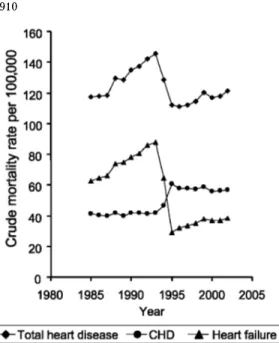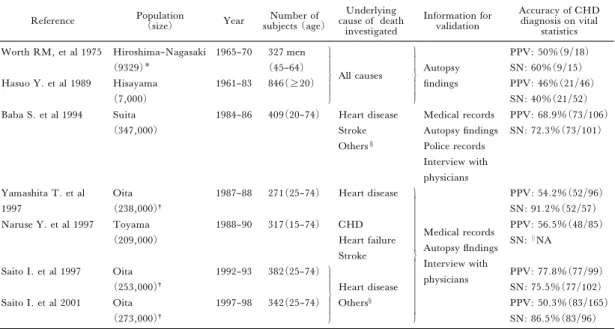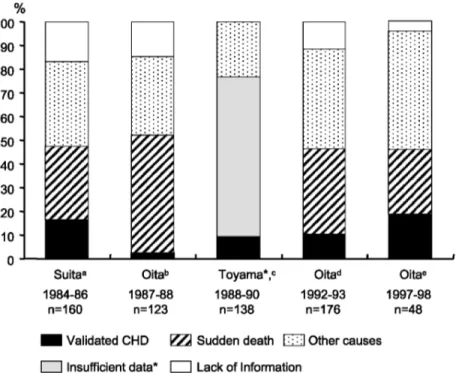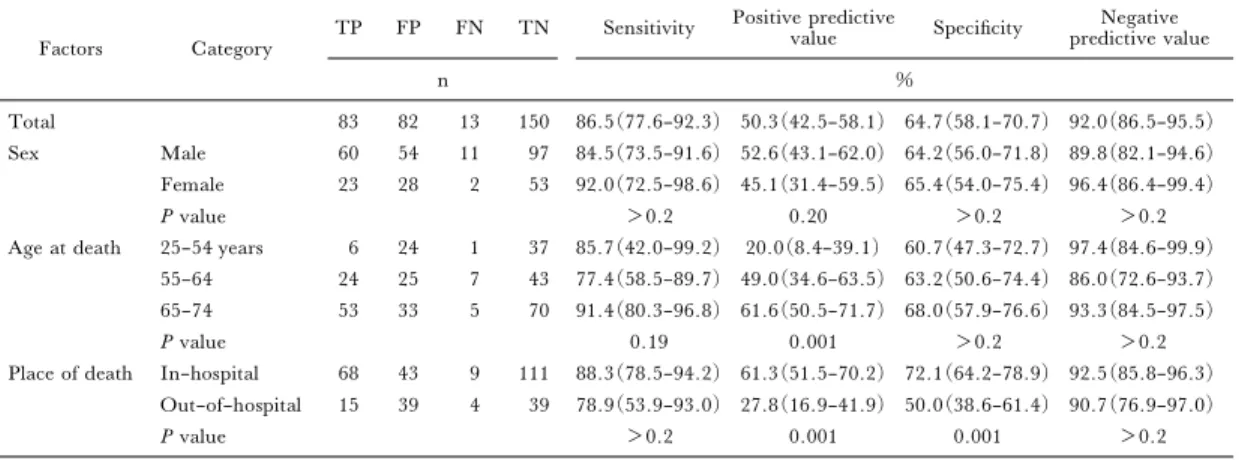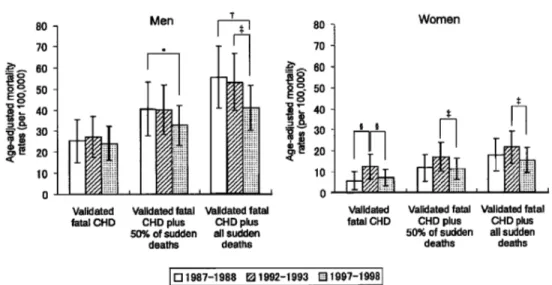* Department of Public Health, Nara Medical Universi-ty, 840 Shijo-cho, Kashihara, Nara 634–8521, Japan E-mail: saitoi@naramed-u.ac.jp
REVIEW OF DEATH CERTIFICATE DIAGNOSIS OF
CORONARY HEART DISEASE AND HEART FAILURE IN JAPAN
Isao SAITO*Vital statistics for coronary heart disease (CHD) were dramatically in‰uenced by the tenth revi-sion of the International Classiˆcation of Diseases (ICD–10) in 1995. To better understand the ac-curacy of death certiˆcate diagnosis of CHD and heart failure, validation studies in Japan were rev-iewed. Positive predictive values and sensitivity, calculated as validation measures, varied widely be-tween studies, diŠering with regard to autopsy rates, amount of information on medical records, and period investigated. However, heart failure, which has been frequently assigned on death certiˆcates in Japan, was validated in some studies. Half of these were evaluated to be sudden deaths, including coronary deaths. Because autopsy-based studies on sudden deaths indicated that 30–50% of these were accounted for by CHD deaths, deaths assigned to heart failure should be taken into considera-tion in order to determine the actual number of CHD deaths in Japan. Focusing on changes in vital statistics after the 1995 ICD revision, the Oita Cardiac Death Surveys (OCDS) allowed interpreta-tion of its eŠects on CHD and heart failure. Much of the increase in CHD deaths on vital statistics re‰ects more false positive cases, particularly for out-of-hospital deaths. Considering the Japanese features of vital statistics for CHD, further epidemiological validation studies are needed in order to conˆrm the accuracy of CHD death certiˆcate diagnoses and to monitor actual CHD trends in Japan. Key words:coronary disease; vital statistics; sudden death; validation; review
I. Introduction
Although o‹cial vital statistics on coronary heart disease (CHD) provide useful information on trends and patterns of CHD throughout the whole country and in regional communities, they are not considered to be su‹ciently reliable for epidemiolog-ical purposes1,2). This is because vital statistics re‰ect
varying diagnostic preferences, coding processes, and autopsy rates among communities3~6).
Heart failure is a very commonly assigned as an underlying cause of death in Japan. However, an au-topsy study provided evidence that this is not appropriate7) because Japanese physicians assign
heart failure to acute deaths lacking symptoms and signs or to deaths occurring during the end stages of cancer or stroke. The over assignation of deaths to heart failure in Japan can thus be considered due to individual diagnostic practices8), leading to concerns
about trends in CHD vital statistics in Japan9).
In 1994, before the 1995 implementation of the 10th International Classiˆcation of Diseases (ICD–10), the Ministry of Health and Welfare of
Japan instructed physicians to avoid using heart failure nonspeciˆcally in completing death certiˆ-cates and to carefully record not only the apparent immediate cause of death and also the probable derlying cause. As a result, mortality assigned to un-derlying CHD increased markedly by 36% between 1993 and 1995, while the heart failure mortality rate decreased by 70%, as shown in Figure 110,11).
In order to validate CHD diagnosis on death certiˆcates, Dr Ozawa and his colleagues, including myself conducted the Oita Cardiac Death Survey (OCDS) for data on individuals who died in Oita due to heart and other CHD-related diseases during 1987–8812), 1992–9313), and 1997–9814). In this
report, while focusing on our OCDS results, we rev-iew validation studies on vital statistics for CHD and heart failure in Japan and address the features of the vital statistics for CHD before and after the ICD re-vision. Additionally, recent mortality and incidence trends in CHD are discussed.
II. Validation studies on fatal coronary heart disease in Japan
The validity of diagnosis on death certiˆcates generally refers to the degree to which the phys-ician's diagnosis was based on medical ˆndings in
ac-Figure 1. Vital statistics on crude mortality rates for total heart disease, coronary heart disease (CHD), and heart disease from 1985 to 2002.
Note: Although death certiˆcates were revised in 1995, the Ministry of Health and Welfare of Japan introduced new guidelines to physicians in 1994. Some eŠect on CHD and heart failure vital statistics was thus observed already in 1994.
Source: Vital statistics of Japan (1985–2002).
cordance with the gold standard World Health Or-ganization (WHO) Monitoring Trends and Deter-minants in Cardiovascular Disease (MONICA) project criteria15). These criteria include diagnostic
components for chest pain, enzymes, electrocardio-gram, autopsy, and previous CHD history. In this report, true fatal CHD is deˆned as `deˆnite fatal AMI' or `possible fatal AMI or CHD death' based on the MONICA criteria.
A summary of validation studies on fatal CHD in Japan is shown in Table 1. In order to conˆrm the accuracy of death certiˆcates, we have calculated the positive predictive value (PPV) and sensitivity (SN) as validation measures using standard formulae16,17). The PPV indicates the percentage of
individuals assigned an underlying cause of CHD on the death certiˆcate and who met the fatal CHD criteria after validation. SN gives the percentage of validated CHD deaths with CHD as the underlying cause on the death certiˆcate.
The Ni-Hon-San study18) validated diagnosis
on death certiˆcates based on autopsy ˆndings as the gold standard. The Japanese cohort in the collabora-tive study included 327 deaths (age at death, 45–64
years) that were autopsied between 1965 and 1970 (autopsy rate, 33%). The CHD diagnosis had a PPV of 50% and an SN of 60%. Similarly, the Hisayama study19) documented the accuracy of
cause of death on vital statistics in residents who died at age 20 years or over between 1961 and 1983. Vali-dation was performed based only on autopsy ˆnd-ings, which had been performed on most individuals in the study (autopsy rate, 79%). The PPV and SN for diagnosis of fatal CHD were found to be 46% and 40%, respectively. In the Suita study20), 409
deaths classiˆed as due to heart disease, stroke or other causes were investigated in a large population and were reclassiˆed based on the MONICA criter-ia. In particular, they reviewed police records, in-cluding postmortem records, to obtain detailed infor-mation on items such as the presence of witnesses. The PPV and SN in this study were 68.9% and 72.3%. They validated 67 stroke deaths in order to investigate whether CHD death was included; however, there was no fatal CHD among cases desig-nated as stroke. The Toyama study21)was designed
to validate fatal CHD, heart failure and stroke as un-derlying causes of death. Information for the valida-tion was similar to the Oita study, and the PPV was calculated as 56.5%.
In Oita city, validation studies were performed three times; 1987–1988, 1992–93, and 1997–98. The ˆrst was carried out for heart disease deaths and the other two for other causes related to CHD. Because few autopsies were performed (autopsy rate, <3%), information on the medical records and interviews with physicians were primarily used for validation. Oita PPV and SN values varied ranged from 50.3 to 77.8% and 75.5 to 91.2%, respectively. The ICD–10 revision in 1995 greatly in‰uenced CHD di-agnosis on death certiˆcates, as seen in Figure 1. The 1997–98 OCDS data after the revision showed a PPV of 50.3% and an SN of 86.5%. The eŠects of the revision on vital statistics will be discussed in sec-tion IV.
III. EŠect of heart failure as an underlying cause of death on CHD vital statistics
Before ICD–9 was revised to ICD–10, heart failure (ICD–9: 428) as an underlying cause of death accounted for two thirds of total heart disease (Figure 1). The diagnosis of heart failure on death certiˆcates was thus very common in Japan. Because the number of deaths due to heart failure was in-creasing, some argued that numerous CHD deaths were thereby hidden, leading to an underestimation of this cause in Japan22). In addition, a postmortem
Table 1. Summary of validation studies on mortality due to coronary heart disease on death certiˆcates in Japan.
Reference Population(size) Year subjects (age)Number of cause of deathUnderlying investigated Information for validation Accuracy of CHD diagnosis on vital statistics Worth RM, et al 1975 Hiroshima–Nagasaki (9329) 1965–70 327 men (45–64) All causes Autopsy ˆndings PPV: 50%(9/18) SN: 60%(9/15) Hasuo Y. et al 1989 Hisayama (7,000) 1961–83 846(20) PPV: 46%(21/46) SN: 40%(21/52) Baba S. et al 1994 Suita (347,000) 1984–86 409(20–74) Heart disease Stroke Others§ Medical records Autopsy ˆndings Police records Interview with physicians PPV: 68.9%(73/106) SN: 72.3%(73/101) Yamashita T. et al 1997 Oita (238,000)† 1987–88 271(25–74) Heart disease
Medical records Autopsy ‰ndings Interview with physicians PPV: 54.2%(52/96) SN: 91.2%(52/57) Naruse Y. et al 1997 Toyama (209,000) 1988–90 317(15–74) CHD Heart failure Stroke PPV: 56.5%(48/85) SN:||NA Saito I. et al 1997 Oita (253,000)† 1992–93 382(25–74) Heart disease Others§ PPV: 77.8%(77/99) SN: 75.5%(77/102) Saito I. et al 2001 Oita (273,000)† 1997–98 342(25–74) PPV: 50.3%(83/165) SN: 86.5%(83/96) Number of Japanese participants in the Ni–Hon–San study,†Ages 25–74 years,§ Diabetes mellitus (ICD–9: 250; ICD–10: E10–E14),hypertensive disease (401–405; I10–I15), diseases of arteries, arterioles, and capillaries (440–448; I70–I79), and ill–deˆned and unknown causes(797–799; R54, R95–R99).
||NA, not available for calculation, PPV, positive predictive value; SN, sensitivity
heart failure diagnosis between clinical practitioners and postmortem physicians in Japan7).
Validation studies in Japan also examined the diagnosis of heart failure and classiˆed such cases into validated fatal CHD, other causes, sudden death and insu‹cient data, as represented in Figure 2. Validated fatal CHD accounted for 2.4–18.9% of heart failure deaths. Furthermore, 27.1–49.6% cases were classiˆed as sudden death, which included deaths within 24 hours of onset of acute symptoms without reports of ``typical'' or ``atypical'' chest pain, as deˆned by the MONICA criteria, and without clear signs suggesting another cause.
Indeed, approximately half of deaths due to heart failure were validated as CHD or sudden deaths. Therefore, the main di‹culty in counting true fatal CHD occurrences in the population lies in deciding how to estimate fatal CHD hidden among sudden deaths, because epidemiological data based on autopsies indicate that CHD contributes to most sudden deaths occurring within 1 hour of onset23~25).
Based on autopsy ˆndings, the Hisayama study26) between 1961 and 1983 demonstrated the
24.4% and 51.5% of unexpected sudden deaths wi-thin 24 hours were due to CHD and stroke, respec-tively. These percentages changed with time, and the proportion of CHD increased by 33% from 1972 to
1983. A postmortem study indicated that 65.9% of 1,230 sudden deaths examined between 1982 and 1986 in Osaka were caused by cardiac diseases and that 50.7% were due to CHD27). Similarly, 18,189
sudden deaths were investigated in a Tokyo postmortem study from 1989 to 1993, and 45.3% and 44.2% with and without past histories of disease, respectively, were conˆrmed as CHD deaths based on autopsy results28). In a population study from
1989 to 1999 in Saku, it was found that there were 217 sudden deaths within 24 hours, and 35.4% of 55 autopsied cases were diagnosed as CHD29).
Autopsy-based ˆndings imply that 30–50% of unexpected deaths within 24 hours from onset of symptoms are due to CHD, so that, when we assess the actual number of fatal CHD in a community, it is important to take these into consideration.
IV. EŠects of the 1995 ICD–10 revision on CHD vital statistics
ICD changes are known to impact on national vital statistics and the 1995 implementation of ICD–10 in Japan had a particularity large eŠect on both CHD and heart failure data. In this section, we discuss why CHD mortality rates from vital statistics greatly increased in Japan, and present validation
Figure 2. Proportion of validated classiˆcation of certiˆed heart failure in validation studies in Japan. *The Toyama study did not classify sudden death, so the gray region represents insu‹cient data, possibly includ-ing sudden deaths.
Source:aBaba S. et al 1994,bYamashita T. et al 1997,cNaruse Y. et al 1997,dSaito I. et al 1997,eSaito I. et al
2001.
measures based on OCDS data.
The 1997–98 OCDS14) validated deaths based
on the ICD–10 and the generated SN, PPV, speciˆc-ity, and negative predictive values, as calculated for CHD death certiˆcate diagnosis, were 86.5%, 50.3%, 64.7%, and 92.0%, respectively (Table 2). The PPV varied signiˆcantly with age and place of death and the ratio of false positive cases to true posi-tive cases for fatal CHD was highest among those who died at a younger age or out of hospital.
When compared with the 1992–93 data from ICD–930), the SN for an underlying cause of CHD
on death certiˆcates was increased, while the PPV and speciˆcity dropped due to an increase in false positive fatal CHD cases. Stratiˆed by place of death, in-hospital sensitivity, PPV, and speciˆcity values in 1992–93 were 79.0%, 80.0% and 87.9%, while out-of-hospital values were 81.3%, 68.4%, and 90.3%, respectively. These data imply that false positive cases increased, particularly in out-of-hospital deaths, and much of the shift was related to sudden deaths being mostly coded as CHD in ICD–10 versus heart failure in ICD–9.
We do not believe that these substantial mortali-ty shifts were caused by nosologists assigning
diŠer-ent codes or underlying causes based on the new ICD–10 rules. When the Ministry of Health reclassi-ˆed 1994 deaths coded by ICD–9 using ICD–10 rules, heart failure decreased by only 1.6% and AMI decreased by 8.9%31). Rather, we found that the
main cause of this change in CHD vital statistics was the way physicians classiˆed sudden deaths, the majority of which were out-of-hospital32). Due to low
autopsy rates, unexpected deaths were, generally classiˆed as heart failure on death certiˆcates in ICD–9, as reported elsewhere20,33). Furthermore,
upon validation, the ICD–9 heart failure classiˆca-tion was found to include many in-hospital deaths from causes other than heart disease. These data sug-gest that physicians misused heart failure as a cause of death in ICD–9. In contrast, after national in-struction on ICD–10, physicians assigned CHD on certiˆcates of deaths that were sudden or lacking clear signs suggestive of other causes.
Taking these facts into consideration, the OCDS showed the PPV and speciˆcity to be lower in ICD–10. The ˆndings clearly suggest that false posi-tive fatal CHD cases increased and that physicians might be using an underlying cause of CHD nonspe-ciˆcally on death certiˆcates in ICD–10.
Table 2. Sensitivity, positive predictive value, speciˆcity, and negative predictive value for CHD death certiˆcate di-agnosis in the 1997–98 OCDS.
Factors Category
TP FP FN TN Sensitivity Positive predictive
value Speciˆcity Negative predictive value n % Total 83 82 13 150 86.5(77.6–92.3) 50.3(42.5–58.1) 64.7(58.1–70.7) 92.0(86.5–95.5) Sex Male 60 54 11 97 84.5(73.5–91.6) 52.6(43.1–62.0) 64.2(56.0–71.8) 89.8(82.1–94.6) Female 23 28 2 53 92.0(72.5–98.6) 45.1(31.4–59.5) 65.4(54.0–75.4) 96.4(86.4–99.4) P value >0.2 0.20 >0.2 >0.2 Age at death 25–54 years 6 24 1 37 85.7(42.0–99.2) 20.0(8.4–39.1) 60.7(47.3–72.7) 97.4(84.6–99.9)
55–64 24 25 7 43 77.4(58.5–89.7) 49.0(34.6–63.5) 63.2(50.6–74.4) 86.0(72.6–93.7) 65–74 53 33 5 70 91.4(80.3–96.8) 61.6(50.5–71.7) 68.0(57.9–76.6) 93.3(84.5–97.5) P value 0.19 0.001 >0.2 >0.2 Place of death In–hospital 68 43 9 111 88.3(78.5–94.2) 61.3(51.5–70.2) 72.1(64.2–78.9) 92.5(85.8–96.3)
Out–of–hospital 15 39 4 39 78.9(53.9–93.0) 27.8(16.9–41.9) 50.0(38.6–61.4) 90.7(76.9–97.0) P value >0.2 0.001 0.001 >0.2 TP: true positive, FP: false positive, FN: false negative, TN: true negative
95% conˆdence interval ( )
Source: Reprinted with permission from the Japanese Journal of Public Health, Vol 48, No 8, P 589,2001 Japanese Society of Public Health.
Finally, the number of heart failures is gradual-ly increasing from the 1995 level on vital statistics, particularly for in-hospital deaths. We should there-fore continue to follow this curious phenomenon, which is probably caused by diagnostic practices that have become very common.
V. Incidence, mortality, and their trends in CHD in Japan
As described in previous sections, vital statistics for CHD have been aŠected by diagnostic practices and ICD revisions in Japan. Moreover, given the in-formation on unexpected sudden deaths, it is very di‹cult to visualize the actual trend in fatal CHD us-ing only vital statistics. Nonetheless, questions regarding actual fatal CHD trends often arise in the ˆeld of public health and preventive medicine.
Since epidemiological studies on fatal CHD trends with large populations in Japan are rare, there are limited data to clearly identify any trend. The OCDS conducted 3 validation studies and showed validated fatal CHD trends from 1987 to 199832)
(Figure 3). When classifying sudden deaths within 24 hours of onset as CHD deaths, validated CHD mortality rates in men and women did not increase during this period. Rather, total or out-of-hospital CHD deaths in men tended to decrease.
CHD mortality trends by place of death provide valuable insight when looking at preventive eŠects in a population34,35). Though the US deˆnition of
in-hospital and out-of-in-hospital deaths diŠers from the Japanese deˆnition for DOA (dead on arrival)
cases, it is commonly considered that out-of-hospital CHD trends which have been clearly declining in the US population34,35) re‰ect primary prevention
eŠects.
In the 1990s, incidence rates for CHD in Japan were considered based on various social factors using a community-based registration system29,36,37).
Although it is impossible to directly compare event rates, because of variation in the registration system and subject conditions, such as history of CHD or age range investigated, each study consistently em-phasized the low Japanese CHD incidence when compared with those in Europe and the US.
In order to conˆrm actual diŠerences in CHD mortality rates between Japan and the US, a com-parison study of validated fatal CHD cases was per-formed using data from the OCDS and the Atheros-clerosis Risk in Communities (ARIC) study33).
Four-fold diŠerences in fatal CHD were observed, even if authors included the number of CHD deaths reported as sudden deaths. Particularly large diŠer-ences were seen between out-of–hospital fatal CHD in Japan and the US.
Secular CHD incidence trends in the communi-ty were also described in long-term follow-up studies38~41). Kitamura et al. demonstrated the
CHD incidence rates for Osaka men aged 40–59 years to have increased from 1963–70 to 1987–94, but they have remained almost level over the last two decades40). Unchanged secular trends in incidence
and mortality rates for CHD were seen in the Hisayama study from 1961–73 to 1988–200041). On
Figure 3. Trends in age-adjusted mortality rates due to validated fatal CHD, validated fatal CHD plus 50% of sudden deaths, and validated fatal CHD plus all sudden deaths from 1987 to 1998 among people aged 25–74 years in Oita City, Japan. Validated fatal CHD comprised `Deˆnite fatal AMI' and `Possible fatal AMI or CHD death.' *P for trend=0.09 and†P for trend= 0.03;‡P<0.1,§P<0.05 for diŠerence.
Source: Reprinted from Journal of Clinical Epidemiology, Vol 55, No 5, Saito I, Trends in fatal coronary heart disease among people aged 25–74 years in Oita City, Japan, from 1987–1998, P 472, C2002 with permission from Elsevier, Inc.
over showed a trend for increased CHD incidence. Although there were small numbers of cardiovascu-lar events in such cohort studies for analysis, secucardiovascu-lar changes in CHD risk factors, such as blood pressure and total cholesterol levels, were very useful in inter-preting the trends observed in the general popula-tion.
VI. Conclusion
Numerous validation studies of CHD death cer-tiˆcate diagnosis have been reported in Europe and the US16,17,42~44). In an overview of seven validation
studies in Japan, autopsy rates, the amount of infor-mation for validation, and the ICD version were found to in‰uence to some extent the validation measures over time. Based on OCDS ˆndings, ICD–10 death certiˆcate diagnosis of CHD was characterized by a high SN and a low PPV, indicat-ing an increase in the frequency of CHD diagnosis for people who died suddenly without information on symptoms or medical evidence. Epidemiological validation studies are needed to conˆrm the accuracy of CHD death certiˆcate diagnoses in order to moni-tor actual CHD trends for public health purposes. Continuing population-based validation studies will play an important role in solving the controversial is-sue of whether CHD mortality trends in Japan are indeed increasing.
References
1) Stehbens WE. An appraisal of the epidemic rise of co-ronary heart disease and its decline. Lancet 1987; 1: 606–611.
2) Smith CJ, Scott SM, Wagner BM. The necessary role of the autopsy in cardiovascular epidemiology. Hum Pathol 1998; 29: 1469–1479.
3) Sorlie PD, Gold EB. The eŠect of physician terminol-ogy preference on coronary heart disease mortality: an artifact uncovered by the 9th revision ICD. Am J Public Health 1987; 77: 148–152.
4) Phillips R, Carson P, Haites N, et al. Variation in mortality from ischaemic heart disease between En-gland and Scotland. Q J Med 1987; 63: 441–448. 5) Lee MH, Borhani NO, Kuller LH. Validation of
reported myocardial infarction mortality in blacks and whites. A report from the Community Cardiovascular Surveillance Program. Ann Epidemiol 1990; 1: 1–12. 6) Jansson B, Johansson LA, Rosen M, et al. National
adaptations of the ICD rules for classiˆcation–a problem in the evaluation of cause-of-death trends. J Clin Epidemiol 1997; 50: 367–375.
7) Saijoh K, Fukunaga T, Ajiki W. Mortality in medicolegal deaths in Hyogo Prefecture (1986–88). Jpn J Hygiene 1991; 46: 958–965.
8) Uemura K, Pisa Z. Trends in cardiovascular disease mortality in industrialized countries since 1950. World Health Stat Q 1988; 41: 155–178.
9) Sekikawa A, Satoh T, Hayakawa T, et al. Coronary heart disease mortality among men aged 35–44 years by
prefecture in Japan in 1995–1999 compared with that among white men aged 35–44 by state in the United States in 1995–1998: vital statistics data in recent birth cohorts. Jpn Circ J 2001; 65: 887–892.
10) Statistics and Information Department, Ministry of Health and Welfare. Vital Statistics of Japan, 1998 Tokyo: Health and Welfare Statistics Association; 2000.
11) Saito I, Ozawa H, Aono H, et al. Change of the number of heart disease deaths according to the revision of the death certiˆcates in Oita city. Jpn J Public Health 1997; 44: 874–879. (in Japanese)
12) Yamashita T, Ozawa H, Aono H, et al. Heart dis-ease deaths on death certiˆcates re-evaluated by clinical records in a Japanese city. Jpn Circ J 1997; 61: 331–338.
13) Saito I, Ozawa H, Aono H, et al. Reevaluation of heart disease deaths on death certiˆcates and trends for ischemic heart disease mortality during the last ˆve years in Oita city. Jpn J Public Health 1997; 44: 292–303. (in Japanese)
14) Saito I, Aono H, Ikebe T, et al. The validity of revised death certiˆcates (ICD–10) for ischemic heart disease in Oita City, Japan. Jpn J Public Health 2001; 48: 584–594. (in Japanese)
15) Tunstall-Pedoe H, Kuulasmaa K, Amouyel P, et al. Myocardial infarction and coronary deaths in the World Health Organization MONICA Project. Registration procedures, event rates, and case-fatality rates in 38 populations from 21 countries in four continents. Circu-lation 1994; 90: 583–612.
16) Coady SA, Sorlie PD, Cooper LS, et al. Validation of death certiˆcate diagnosis for coronary heart disease: the Atherosclerosis Risk in Communities (ARIC) Study. J Clin Epidemiol 2001; 54: 40–50.
17) Mahonen M, Salomaa V, Torppa J, et al. The validi-ty of the routine mortalivalidi-ty statistics on coronary heart disease in Finland: comparison with the FINMONICA MI register data for the years 1983–1992. Finnish mul-tinational MONItoring of trends and determinants in CArdiovascular disease. J Clin Epidemiol 1999; 52: 157–166.
18) Worth RM, Kato H, Rhoads GG, et al. Epidemio-logic studies of coronary heart disease and stroke in Japanese men living in Japan, Hawaii and California: mortality. Am J Epidemiol 1975; 102: 481–490. 19) Hasuo Y, Ueda K, Kiyohara Y, et al. Accuracy of
di-agnosis on death certiˆcates for underlying causes of death in a long-term autopsy-based population study in Hisayama, Japan; with special reference to cardiovas-cular diseases. J Clin Epidemiol 1989; 42: 577–584. 20) Baba S, Ozawa H, Sakai Y, et al. Heart disease
deaths in a Japanese urban area evaluated by clinical and police records. Circulation 1994; 89: 109–115. 21) Naruse Y, Nakagawa H, Yamagami T, et al.
Ischaemic heart disease deaths in a Japanese rural area evaluated by clinical records. J Epidemiol 1997; 7: 71–76.
22) Toshima H. Coronary artery disease trends in Japan. Jpn Circ J 1994; 58: 166–172.
23) Spain DM, Bradess VA, Mohr C. Coronary atheros-clerosis as a cause of unexpected and unexplained death: an autopsy study from 1949–1959. JAMA 1960; 24: 122–126.
24) Kuller L, Lilienfeld A, Fisher R. Epidemiological study of sudden and unexpected deaths due to arterios-clerotic heart disease. Circulation 1966; 34: 1056–1068. 25) Yano K, McCarthy LJ, Reed DM, et al. Postmortem ˆndings in sudden and non-sudden deaths among Japanese-American men in Hawaii. Am J Med 1987; 83: 1037–1044.
26) Hasuo Y. Sudden and unexpected deaths observed in the Hisayama residents during 22–year follow-up. Fukuoka Igaku Zasshi 1987; 78: 164–180.
27) Matoba R, Shikata I, Iwai K, et al. An epidemiologic and histopathological study of sudden cardiac death in Osaka Medical Examiner's O‹ce. Jpn Circ J 1989; 53: 1581–1588.
28) Tokudome S, Matsuo Y, Hamamatsu M, et al. Tot-suzensi no bouken-rei karano kentou. Therapeutic Research 1996; 17: 241–278. (in Japanese)
29) Takamatsu M, Kondo T, Yamamura K, et al. Inci-dence of myocardial infarction in Saku Area: registra-tion of onset of myocardial infarcregistra-tion and autopsied ˆndings of sudden deaths. Journal of the Japanese As-sociation for Cerebro-cardiovascular Disease Control 1999; 34: 10–15. (in Japanese)
30) Saito I, Ozawa H, Aono H, et al. Reevaluation of heart disease deaths on death certiˆcates and trends for ischemic heart disease mortality during the last ˆve years in Oita city. Jpn J Public Health 1997; 44: 292–303. (in Japanese)
31) Health and Welfare Association. Journal of Health and Welfare Statistics. Tokyo: Health and Welfare Statistics Association, 1997; 72–76. (in Japanese) 32) Saito I, Ozawa H, Aono H, et al. Trends in fatal
co-ronary heart disease among people aged 25–74 years in Oita City, Japan, from 1987–1998. J Clin Epidemiol 2002; 55: 469–476.
33) Saito I, Folsom AR, Aono H, et al. Comparison of fatal coronary heart disease occurrence based on popu-lation surveys in Japan and the USA. Int J Epidemiol 2000; 29: 837–844.
34) Rosamond WD, Chambless LE, Folsom AR, et al. Trends in the incidence of myocardial infarction and in mortality due to coronary heart disease, 1987 to 1994. N Engl J Med 1998; 339: 861–867.
35) McGovern PG, Pankow JS, Shahar E, et al. Recent trends in acute coronary heart disease––mortality, mor-bidity, medical care, and risk factors. The Minnesota Heart Survey Investigators. N Engl J Med 1996; 334: 884–890.
36) Fukiyama K, Kimura Y, Wakugami K, et al. Inci-dence and long-term prognosis of initial stroke and a-cute myocardial infarction in Okinawa, Japan. Hyper-tens Res 2000; 23: 127–135.
37) Tanabe N, Saito R, Sato T, et al. Event rates of acute myocardial infarction and coronary deaths in Niigata and Nagaoka cities in Japan. Circ J 2003; 67: 40–45. 38) Shimamoto T, Komachi Y, Inada H, et al. Trends
for coronary heart disease and stroke and their risk fac-tors in Japan. Circulation 1989; 79: 503–515. 39) Kodama K, Sasaki H, Shimizu Y. Trend of coronary
heart disease and its relationship to risk factors in a Japanese population: a 26–year follow-up, Hiroshima/ Nagasaki study. Jpn Circ J 1990; 54: 414–421. 40) Kitamura A, Iso H, Iida M, et al. Trends in the
inci-dence of coronary heart disease and stroke and the prevalence of cardiovascular risk factors among Japanese men from 1963 to 1994. Am J Med 2002; 112: 104–109.
41) Kubo M, Kiyohara Y, Kato I, et al. Trends in the in-cidence, mortality, and survival rate of cardiovascular disease in a Japanese community: the Hisayama study. Stroke 2003; 34: 2349–2354.
42) Lloyd-Jones DM, Martin DO, Larson MG, et al. Accuracy of death certiˆcates for coding coronary heart disease as the cause of death. Ann Intern Med 1998; 129: 1020–1026.
43) Folsom AR, Gomez-Marin O, Gillum RF, et al. Out-of-hospital coronary death in an urban population–validation of death certiˆcate diagnosis. The Minnesota Heart Survey. Am J Epidemiol 1987; 125: 1012–1018.
44) De Henauw S, de Smet P, Aelvoet W, et al. Misclas-siˆcation of coronary heart disease in mortality statis-tics. Evidence from the WHO-MONICA Ghent-Charleroi Study in Belgium. J Epidemiol Community Health 1998; 52: 513–519.
